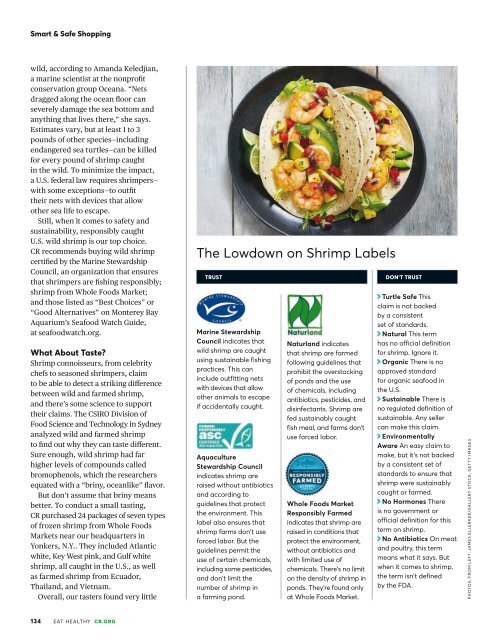You also want an ePaper? Increase the reach of your titles
YUMPU automatically turns print PDFs into web optimized ePapers that Google loves.
Smart & Safe Shopping<br />
wild, according to Am<strong>and</strong>a Keledjian,<br />
a marine scientist at the nonprof<strong>it</strong><br />
conservation group Oceana. “Nets<br />
dragged along the ocean floor can<br />
severely damage the sea bottom <strong>and</strong><br />
anything that lives there,” she says.<br />
Estimates vary, but at least 1 to 3<br />
pounds of other species—including<br />
endangered sea turtles—can be killed<br />
for every pound of shrimp caught<br />
in the wild. To minimize the impact,<br />
a U.S. federal law requires shrimpers—<br />
w<strong>it</strong>h some exceptions—to outf<strong>it</strong><br />
their nets w<strong>it</strong>h devices that allow<br />
other sea life to escape.<br />
Still, when <strong>it</strong> comes to safety <strong>and</strong><br />
sustainabil<strong>it</strong>y, responsibly caught<br />
U.S. wild shrimp is our top choice.<br />
CR recommends buying wild shrimp<br />
certified by the Marine Stewardship<br />
Council, an organization that ensures<br />
that shrimpers are fishing responsibly;<br />
shrimp from Whole Foods Market;<br />
<strong>and</strong> those listed as “Best Choices” or<br />
“Good Alternatives” on Monterey Bay<br />
Aquarium’s Seafood Watch Guide,<br />
at seafoodwatch.org.<br />
What About Taste?<br />
Shrimp connoisseurs, from celebr<strong>it</strong>y<br />
chefs to seasoned shrimpers, claim<br />
to be able to detect a striking difference<br />
between wild <strong>and</strong> farmed shrimp,<br />
<strong>and</strong> there’s some science to support<br />
their claims. The CSIRO Division of<br />
Food Science <strong>and</strong> Technology in Sydney<br />
analyzed wild <strong>and</strong> farmed shrimp<br />
to find out why they can taste different.<br />
Sure enough, wild shrimp had far<br />
higher levels of compounds called<br />
bromophenols, which the researchers<br />
equated w<strong>it</strong>h a “briny, oceanlike” flavor.<br />
But don’t assume that briny means<br />
better. To conduct a small tasting,<br />
CR purchased 24 packages of seven types<br />
of frozen shrimp from Whole Foods<br />
Markets near our headquarters in<br />
Yonkers, N.Y.. They included Atlantic<br />
wh<strong>it</strong>e, Key West pink, <strong>and</strong> Gulf wh<strong>it</strong>e<br />
shrimp, all caught in the U.S., as well<br />
as farmed shrimp from Ecuador,<br />
Thail<strong>and</strong>, <strong>and</strong> Vietnam.<br />
Overall, our tasters found very l<strong>it</strong>tle<br />
The Lowdown on Shrimp Labels<br />
TRUST<br />
Marine Stewardship<br />
Council indicates that<br />
wild shrimp are caught<br />
using sustainable fishing<br />
practices. This can<br />
include outf<strong>it</strong>ting nets<br />
w<strong>it</strong>h devices that allow<br />
other animals to escape<br />
if accidentally caught.<br />
Aquaculture<br />
Stewardship Council<br />
indicates shrimp are<br />
raised w<strong>it</strong>hout antibiotics<br />
<strong>and</strong> according to<br />
guidelines that protect<br />
the environment. This<br />
label also ensures that<br />
shrimp farms don’t use<br />
forced labor. But the<br />
guidelines perm<strong>it</strong> the<br />
use of certain chemicals,<br />
including some pesticides,<br />
<strong>and</strong> don’t lim<strong>it</strong> the<br />
number of shrimp in<br />
a farming pond.<br />
Naturl<strong>and</strong> indicates<br />
that shrimp are farmed<br />
following guidelines that<br />
prohib<strong>it</strong> the overstocking<br />
of ponds <strong>and</strong> the use<br />
of chemicals, including<br />
antibiotics, pesticides, <strong>and</strong><br />
disinfectants. Shrimp are<br />
fed sustainably caught<br />
fish meal, <strong>and</strong> farms don’t<br />
use forced labor.<br />
Whole Foods Market<br />
Responsibly Farmed<br />
indicates that shrimp are<br />
raised in cond<strong>it</strong>ions that<br />
protect the environment,<br />
w<strong>it</strong>hout antibiotics <strong>and</strong><br />
w<strong>it</strong>h lim<strong>it</strong>ed use of<br />
chemicals. There’s no lim<strong>it</strong><br />
on the dens<strong>it</strong>y of shrimp in<br />
ponds. They’re found only<br />
at Whole Foods Market.<br />
DON’T TRUST<br />
Turtle Safe This<br />
claim is not backed<br />
by a consistent<br />
set of st<strong>and</strong>ards.<br />
Natural This term<br />
has no official defin<strong>it</strong>ion<br />
for shrimp. Ignore <strong>it</strong>.<br />
Organic There is no<br />
approved st<strong>and</strong>ard<br />
for organic seafood in<br />
the U.S.<br />
Sustainable There is<br />
no regulated defin<strong>it</strong>ion of<br />
sustainable. Any seller<br />
can make this claim.<br />
Environmentally<br />
Aware An easy claim to<br />
make, but <strong>it</strong>’s not backed<br />
by a consistent set of<br />
st<strong>and</strong>ards to ensure that<br />
shrimp were sustainably<br />
caught or farmed.<br />
No Hormones There<br />
is no government or<br />
official defin<strong>it</strong>ion for this<br />
term on shrimp.<br />
No Antibiotics On meat<br />
<strong>and</strong> poultry, this term<br />
means what <strong>it</strong> says. But<br />
when <strong>it</strong> comes to shrimp,<br />
the term isn’t defined<br />
by the FDA.<br />
PHOTOS, FROM LEFT: JAMES ELLERKER/GALLERY STOCK; GETTY IMAGES<br />
134 EAT HEALTHY CR.ORG


















